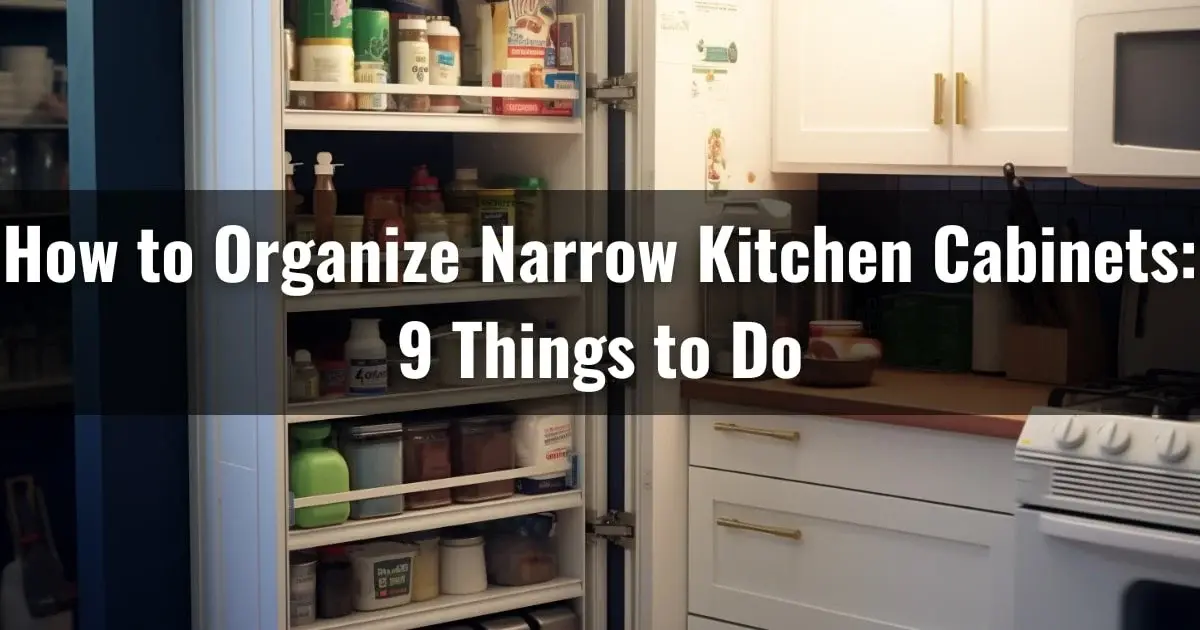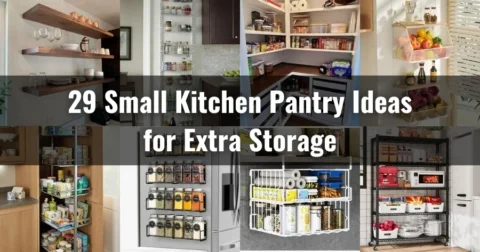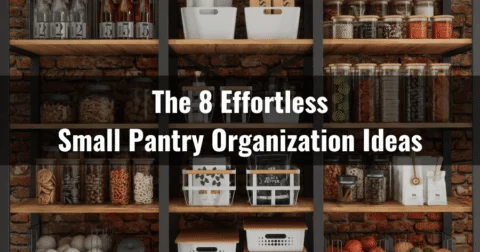Organizing your narrow kitchen cabinets can help you achieve an efficient and clutter-free culinary haven. You need to take a step-by-step approach and implement some creative solutions to transform these tight quarters into streamlined storage marvels.
For organizing narrow kitchen cabinets, you need to empty the cabinets. You should also categorize your kitchen essentials, grouping similar items for easy accessibility.
Consider using narrow, deep bins for bottles and liquids to slide the essentials out when needed. To make the most of vertical space, slide cutting boards, baking sheets, and cooling racks into the space.
Also, hang magazine holders to organize foils and wraps in tight spots; labeling them adds another layer of convenience. Install pullout racks to maximize your limited storage space.
We’ll go through the process in more detail and explore some ingenious ways to make the most of every inch.
How to Organize Narrow Kitchen Cabinets: A Complete Guide
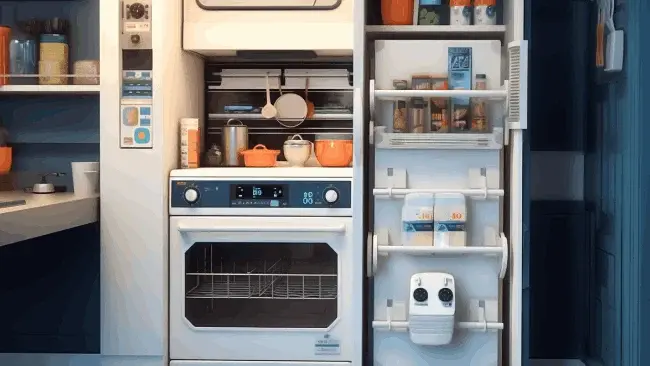
To organize narrow kitchen cabinets, we identified several essential strategies that can assist you in organizing your kitchen cabinets efficiently. The following are the procedures you should follow:
- Assess your cabinet space
- Empty the cabinets
- Categorize your items
- Use narrow, deep bins
- Consider interior organizers
- Slide in cutting boards and baking sheets
- Magazine holders for foils and wraps
- File pot holders and oven mitts
- Install pullout racks
To ensure that you can effectively organize narrow kitchen cabinets, let’s discuss each item in detail.
1. Assess Your Cabinet Space
To start organizing your narrow kitchen cabinets, carefully assess their dimensions. Measure the height, width, and depth of your cabinets and make a note of them. Knowing the precise dimensions of your cabinets will help you plan how to use the space effectively.
Once you have the measurements, think about which items you use the most and which ones you rarely use. This way, you can plan to place your most-used items in easy-to-reach areas and store your infrequently used items in higher or lower tiers.
2. Empty the Cabinets
Now, you have to empty the cabinets. Start by removing all items from the cabinets and placing them on a nearby surface.
This process allows you to begin with a clean slate and gives you a clear view of what you have and what you need to organize.
After you’ve removed all items, take stock of what you have and decide which items you’ll keep, donate, or discard.
3. Categorize Your Items
Once you’ve emptied the cabinets, start categorizing your items according to their types. Group similar items together to make it easier to find what you need and visualize how to allocate space best.
For example, gather all your spices in one area, cutting boards in another, pot lids in another, and foils and wraps in a separate section.
4. Use Narrow, Deep Bins
When categorizing your items, utilize narrow, deep bins for olive oil, vinegar, and liquid bottles. These bins are perfect for organizing your kitchen cabinets because they maximize the use of vertical space.
Their slim design fits perfectly in narrow cabinets and makes it easy to slide out the items when needed. The deep bins ensure that the bottles stay securely in place and prevent them from tipping over or falling.
5. Consider Interior Organizers
Interior organizers are great space-saving tools, especially if your cabinets lack shelves. Use drawers for storing things like pots, pans, and other bulky items in an organized manner.
For example, you can use a vertical organizer to store baking trays. This way, you can have everything you need within reach, saving you time and effort.
6. Slide in Cutting Boards and Baking Sheets
Consider sliding cutting boards, baking sheets, or cooling racks in to take advantage of your narrow cabinet’s vertical space.
Keep heavier items on one side of your cabinet and lighter items on the other to avoid damaging each other.
7. Magazine Holders for Foils and Wraps
Magazine holders are an inexpensive yet effective way to organize foils and wraps in narrow kitchen cabinets.
Place them in separate holders and label them for easy identification, making it easy to find exactly what you need when you need it.
8. File Pot Holders and Oven Mitts
It’s easy for pot holders and oven mitts to end up in the back of your narrow kitchen cabinet, get lost, or get damaged.
Instead, try storing your pot holders vertically using magazine holders. This way, they’ll always be visible and within reach.
Alternatively, you could stack your pot holders and oven mitts flat on shelves, preventing them from getting lost in the back of your cabinets.
9. Install Pullout Racks

You can maximize your cabinet space by installing pullout racks inside your narrow kitchen cabinets. These racks provide additional storage space, making storing items like spices and smaller jars easier.
They also make accessing items more comfortable by letting you slide the rack out. Installing pullout racks is a great way to maximize your narrow kitchen cabinets.
Common Challenges in Organizing Narrow Kitchen Cabinets and Their Solutions
When organizing your narrow kitchen cabinets, you may encounter some common challenges. Let’s talk about how to fix these problems and maximize narrow kitchen cabinet organization.
1. Dead Space
Narrow kitchen cabinets are notorious for having dead space that goes unused. This can lead to cluttered countertops and a disorganized kitchen.
However, there is a simple solution to this problem. Lower the shelves and organize shorter items at the bottom and taller items at the top.
By doing this, you are maximizing the space and making sure that everything has its place. You can also use stackable containers to keep items organized and easy to access.
2. Shelf Adjustment Difficulty
Sometimes, organizing narrow kitchen cabinets can be a real headache. Plastic clips can make it difficult to adjust shelves, but there is a way to make it easier.
Use alligator-like clips and press them to release the shelves. This will allow you to move the shelves up or down, making organizing items in your kitchen cabinets easier.
You can even invest in adjustable shelves that can be easily moved without the need for clips.
3. Limited Reach
Deep kitchen cabinets can make it difficult to reach items that are stored at the back. Consider using pullout racks or sliding containers to access items more easily.
This will ensure that everything is within reach and in an organized space. You can even install a Lazy Susan to make the most of your corner cabinets, giving you easy access to all of your kitchen items.
How to Maintain Organized Narrow Kitchen Cabinets and Prevent Clutter?
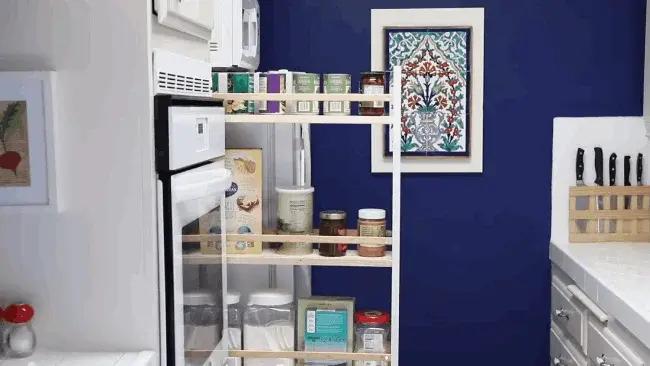
There are several key points to remember to maintain organized, narrow kitchen cabinets and prevent clutter. The following are among them:
1. Regular Decluttering
Regular decluttering is crucial to keep kitchen cabinets organized and clutter-free. Set a schedule to make this a regular part of your kitchen routine.
Depending on your household size, aim to declutter every few months. When decluttering, separate items into keep, donate, and discard categories.
Items that are still in good condition but you no longer use, can be donated, while items that are worn out or expired should be tossed.
2. Group Similar Items
Grouping similar items together in specific cabinets or shelves effectively maintains organization in narrow kitchen cabinets.
For instance, you could designate one cabinet for spices, another for pots, and another for pans. Doing so makes it more convenient to locate items without creating clutter.
Also, consider using clear containers or bins to categorize and contain items in your cabinets.
3. Labeling
Labeling your containers is critical for maintaining the organization of your cabinets. If you use bins or containers to store items, be sure to label them clearly.
Doing so ensures that everyone in your household knows where items belong and helps maintain the organization over time.
4. Resist Overcrowding
Avoid overstuffing your narrow cabinets. Leave some breathing room on your shelves to make it easier to access items and prevent them from toppling over.
Regularly assess your cabinets and declutter or reorganize them as needed when you notice items piling up or overcrowding.
5. Return Items to Their Designated Spots
Train yourself and other family members always to place items in their designated locations after use. This habit ensures long-term organization and will help you prevent clutter from accumulating in your narrow kitchen cabinets.
Take a few minutes each day to check for misplaced items and return them to their proper places. Doing so ensures that your cabinets remain organized and clutter-free.
Frequently Asked Questions
We discovered that many people have asked questions about organizing narrow kitchen cabinets. The following questions may be helpful to you.
How many pounds can a narrow kitchen cabinet cabinet hold?
You can safely load your narrow kitchen cabinet with a weight of up to 50 to 100 pounds per linear foot, depending on its construction and installation.
The weight capacity of these cabinets is influenced by factors such as the quality of their construction, the materials used, and how they are installed.
Generally speaking, narrow kitchen cabinets have similar weight capacities to standard kitchen cabinets. However, it’s important to note that the actual weight limit may vary depending on specific cabinet designs and installation methods.
To ensure you stay within the recommended weight limit, it’s always a good idea to distribute the weight evenly across the cabinet shelves and avoid overloading them. This will help keep your cabinets sturdy and in good condition for a long time.
How do you reinforce narrow kitchen cabinets to hold more weight?
You have a couple of options to reinforce narrow kitchen cabinets and ensure they can hold more weight.
One method is to use plywood on the bottom of each cabinet and secure it with wood screws. This added support layer can distribute the weight more evenly and provide extra stability.

Another option is installing metal braces under the cabinets, particularly useful for medium to heavy items.
These braces can provide additional strength and prevent the cabinets from sagging under the weight of their contents.
How can you make the most of narrow corner cabinets in your kitchen?
To maximize the use of narrow corner cabinets in your kitchen, consider utilizing space-saving solutions like lazy Susans or pull-out trays.
These options optimize access to items tucked away in corners, ensuring nothing gets lost or forgotten.
You can also install corner shelving or tiered organizers to maximize vertical storage space within the cabinet.
Conclusion
Organizing narrow kitchen cabinets can be tedious, but maximizing their space and maintaining an organized look is possible with the right steps and solutions.
You can transform these tight spaces into well-organized storage marvels by following the step-by-step process, implementing creative storage solutions, and addressing common challenges.
Make sure you regularly declutter, group similar items, and label containers to maintain order and prevent clutter.
Reinforce your cabinets if needed and make the most of corner spaces with space-saving options. With these strategies in place, you’ll enjoy a clutter-free and functional kitchen where everything has its place, making meal preparation easier.

